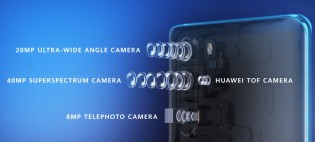Weekly poll: can the Huawei P30 and P30 Pro win your affections?
Huawei redefined mobile photography this week with the unveiling of its P30 flagships. The phones also adopted OLED acoustic screens and reduced the size of the notch. Let's take a closer look.

The 125mm periscope telephoto camera is the crown jewel of the Huawei P30 Pro. It has a fixed focal length, but advanced image processing and data taken from the high-resolution 40MP SuperSpectrum sensor provides a smooth zoom from 1x to nearly 5x (optical), 10x (hybrid) and 50x (digital).
SuperSpectrum refers to a custom sensor from Sony that uses yellow pixels instead of blue. The main camera also features a brighter aperture (f/1.6), so it improves on the already class-leading low-light performance of the Mate 20 Pro camera. Both the 40MP and the tele cameras have rock-steady OIS to boot.
There's actually a couple of more cameras on here. The ultra-wide angle camera (0.6x), which has autofocus so it can snap stunning macro shots, and the ToF sensor that helps create more accurate bokeh effects.
The P30 Pro camera produces great quality video, though it's not the very best at this task (especially since it lacks 4K at 60fps video recording).


Huawei P30 Pro has one of the most advanced mobile cameras on the market
Anyway, the Huawei P30 Pro boasts a 4,200mAh battery with 40W fast wired charge and 15W fast wireless charge, plus reverse wireless charging.
The Huawei P30 misses out on the camera upgrades, but what it gets is very close to the Mate 20 Pro setup – 40MP main (f/1.8, SuperSpectrum sensor), 16MP ultra-wide (instead of 20MP) and 8MP telephoto (80mm).
The selfie camera on both P30 models is identical – a 32MP shooter with improved bokeh algorithms. However, Huawei dropped the 3D face scanning hardware to make the notch smaller.
This means you'll have to rely on the in-display fingerprint reader if you want more security. It's present on both models along with something else – acoustic display. The whole display is an earpiece and since this is second-gen tech, the audio is better. This does mean that there are no stereo speakers, however, so Huawei beefed up the single bottom-firing speaker.

The vanilla P30 uses the same Kirin 980 chipset as the Pro model and offers the same RAM capacities. However, the charging features take a step back – "only" 22.5W wired charging and no wireless charging (you need a case for that). Also, the battery is smaller at 3,650mAh.
The P30 is smaller – it has a 6.1" screen instead of 6.47" – but in both cases the panels have 1080p+ resolution. QHD is reserved for the Mate series.
Finally, there's the price. The P30 Pro starts at €1,000 for the 8/128GB model (but a 6/128GB model has been spotted at €900). The P30 starts at €800.
PS. there's also the Huawei P30 lite, but that's not part of the flagship line (it's a rebadged nova 4e).
Which Huawei P30 phone will you get (if any)?
#Google #Android #Smartphones #OS #News @ndrdnws #ndrdnws #AndroidNews
